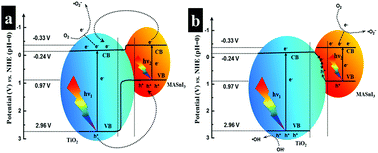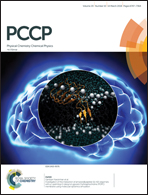Formation of n–n type heterojunction-based tin organic–inorganic hybrid perovskite composites and their functions in the photocatalytic field
Abstract
MASnI3/TiO2 composites (MA represents CH3NH3+) are prepared via a solvothermal method and characterized by various techniques. The results indicate that n–n type heterojunction structures and different ohmic contact interfaces are formed for the composites with different contents of MASnI3 and TiO2 before and after calcination, resulting in different optical and photocatalytic performances. Generally speaking, n–n type heterojunctions play roles in photocatalytic applications through two different mechanisms: the heterojunction mechanism and the Z-type mechanism. The calcined composites with better ohmic contact interfaces mainly follow the Z-type mechanism, which can promote direct radiative recombination of photogenerated carriers. As a result, higher luminous intensities and interface recombination instead of bulk recombination between electrons and holes can be achieved, which improves the photoluminescence and photocatalytic activities of the materials. Moreover, the n–n type heterojunction structure avoids p-type defect states to some degree, which averts the hydrolysis and oxidation of MASnI3 in atmosphere and enhances the long-term stability of the MASnI3/TiO2 composites.



 Please wait while we load your content...
Please wait while we load your content...